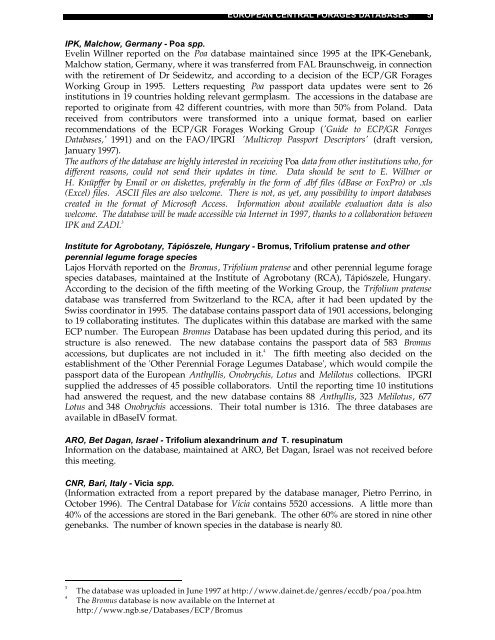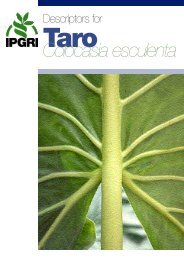Download PDF (6215 kb) - Bioversity International
Download PDF (6215 kb) - Bioversity International
Download PDF (6215 kb) - Bioversity International
Create successful ePaper yourself
Turn your PDF publications into a flip-book with our unique Google optimized e-Paper software.
EUROPEAN CENTRAL FORAGES DATABASES 5<br />
IPK, Malchow, Germany - Poa spp.<br />
Evelin Willner reported on the Poa database maintained since 1995 at the IPK-Genebank,<br />
Malchow station, Germany, where it was transferred from FAL Braunschweig, in connection<br />
with the retirement of Dr Seidewitz, and according to a decision of the ECP/GR Forages<br />
Working Group in 1995. Letters requesting Poa passport data updates were sent to 26<br />
institutions in 19 countries holding relevant germplasm. The accessions in the database are<br />
reported to originate from 42 different countries, with more than 50% from Poland. Data<br />
received from contributors were transformed into a unique format, based on earlier<br />
recommendations of the ECP/GR Forages Working Group ('Guide to ECP/GR Forages<br />
Databases,' 1991) and on the FAO/IPGRI 'Multicrop Passport Descriptors' (draft version,<br />
January 1997).<br />
The authors of the database are highly interested in receiving Poa data from other institutions who, for<br />
different reasons, could not send their updates in time. Data should be sent to E. Willner or<br />
H. Knüpffer by Email or on diskettes, preferably in the form of .dbf files (dBase or FoxPro) or .xls<br />
(Excel) files. ASCII files are also welcome. There is not, as yet, any possibility to import databases<br />
created in the format of Microsoft Access. Information about available evaluation data is also<br />
welcome. The database will be made accessible via Internet in 1997, thanks to a collaboration between<br />
IPK and ZADI. 3<br />
Institute for Agrobotany, Tápiószele, Hungary - Bromus, Trifolium pratense and other<br />
perennial legume forage species<br />
Lajos Horváth reported on the Bromus, Trifolium pratense and other perennial legume forage<br />
species databases, maintained at the Institute of Agrobotany (RCA), Tápiószele, Hungary.<br />
According to the decision of the fifth meeting of the Working Group, the Trifolium pratense<br />
database was transferred from Switzerland to the RCA, after it had been updated by the<br />
Swiss coordinator in 1995. The database contains passport data of 1901 accessions, belonging<br />
to 19 collaborating institutes. The duplicates within this database are marked with the same<br />
ECP number. The European Bromus Database has been updated during this period, and its<br />
structure is also renewed. The new database contains the passport data of 583 Bromus<br />
accessions, but duplicates are not included in it. 4 The fifth meeting also decided on the<br />
establishment of the 'Other Perennial Forage Legumes Database', which would compile the<br />
passport data of the European Anthyllis, Onobrychis, Lotus and Melilotus collections. IPGRI<br />
supplied the addresses of 45 possible collaborators. Until the reporting time 10 institutions<br />
had answered the request, and the new database contains 88 Anthyllis, 323 Melilotus, 677<br />
Lotus and 348 Onobrychis accessions. Their total number is 1316. The three databases are<br />
available in dBaseIV format.<br />
ARO, Bet Dagan, Israel - Trifolium alexandrinum and T. resupinatum<br />
Information on the database, maintained at ARO, Bet Dagan, Israel was not received before<br />
this meeting.<br />
CNR, Bari, Italy - Vicia spp.<br />
(Information extracted from a report prepared by the database manager, Pietro Perrino, in<br />
October 1996). The Central Database for Vicia contains 5520 accessions. A little more than<br />
40% of the accessions are stored in the Bari genebank. The other 60% are stored in nine other<br />
genebanks. The number of known species in the database is nearly 80.<br />
3 The database was uploaded in June 1997 at http://www.dainet.de/genres/eccdb/poa/poa.htm<br />
4 The Bromus database is now available on the Internet at<br />
http://www.ngb.se/Databases/ECP/Bromus




